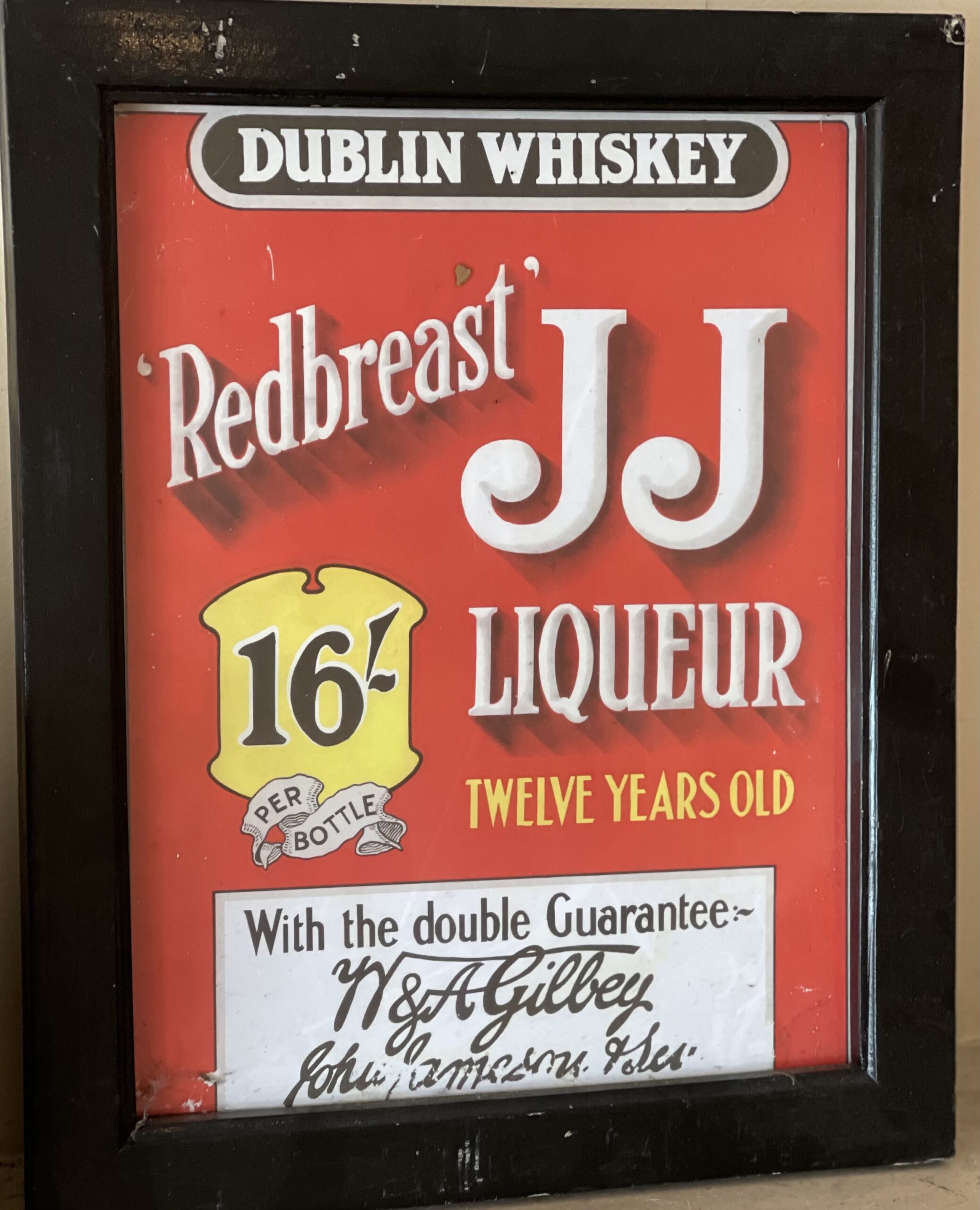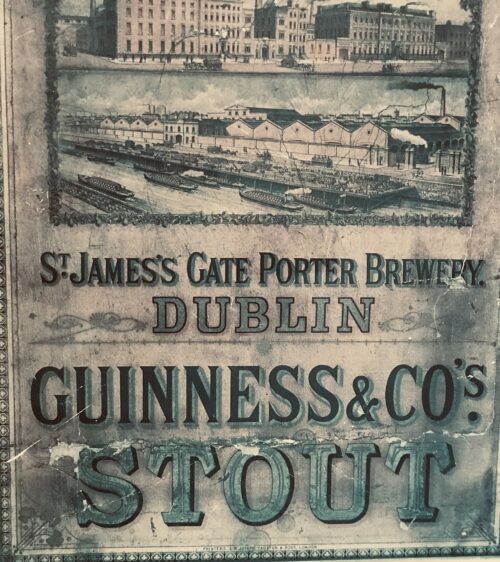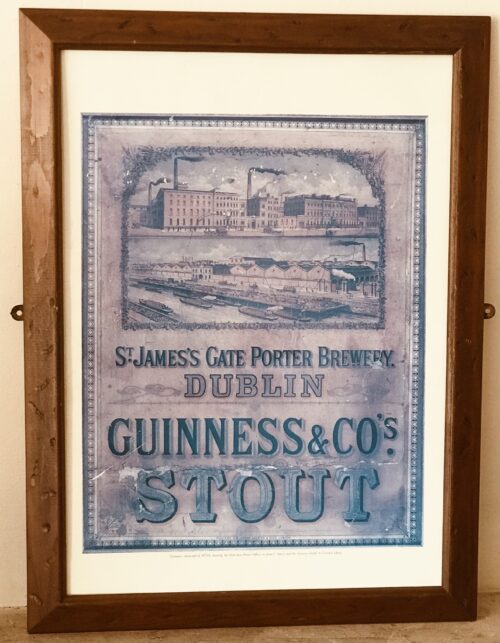Vintage Jameson ‘Redbreast” Irish Whiskey advert – denoting the additional guarantee of quality provided by W & A Gilbey’s.
W & A Gilbey was founded in 1857 and began in small basement cellars at the corner of Oxford Street and Berwick Street in London. Gilbeys benefitted greatly from the introduction of the off-licence system introduced in 1860 and a commercial agreement between Britain and France in 1861, following which, the British Prime Minister Gladstone reduced duty on French wines from 12 shillings to 2 shillings. Gilbeys were successful from the start and, within a couple of years, had branches in Dublin, Belfast and Edinburgh.

1861
Wine importers and distillers
By 1861 Gilbeys had premises at 31 Upper Sackville Street in Dublin (now called O’Connell Street), and were described as wine importers and distillers. They carried stocks of over 140 different wines and held between 700 and 1,000 wine casks under bond.

1866
A distinctive brand
In 1866, the company moved to new offices and stores at 46 & 47 Upper Sackville Street in the centre of Dublin (now O’Connell Street), which contained their own vaults. The buildings were previously the premises of Sneyd, French and Barton. The premises had its own tasting room and a small still for determining the alcoholic strength of wines and spirits. Gilbeys had their own patented bottle cases which could be easily stacked, a state of the art bottle washing machine and by this time, wax seals were replaced with their patented capsule seal. Gilbeys sold all their wines and spirits directly to consumers under their own distinctive brand.

1874
300,000 Gallons in bond
Initially famous for their wines, spirits were becoming a greater part of Gilbey’s business. By 1874, Gilbeys held a stock in bond of over 300,000 gallons of whiskey sourced from “the most celebrated Dublin Distilleries”. The proprietary brand at this time was Gilbey’s Castle Whiskey. They sold three main brands Castle U P Irish Whiskey 33% under proof (u.p.), Castle U V Irish Whiskey 17% u.p. and Castle D O Irish Whiskey at full proof strength.

1875
996,000 Bottles a year
At this point Gilbey’s held the largest stocks of Irish whiskey, outside of the distilleries themselves, of any company in the world. In 1875 they were selling 83,000 cases of Irish whiskey compared with only 38,000 of Scotch, a reflection of the pre-eminence of Irish Whiskey at the time.
887
An alliance with Jameson
By 1887 W & A Gilbey were marketing John Jameson & Son’s ‘sole make’ pure and unblended Irish whiskey. Every bottle of Castle Grand Whiskey had a label certifying that it was Jameson’s and upwards of 6 years old. At the turn of the century, the company held a stock of over 700,000 gallons of John Jameson & Son’s whiskey which was “especially reserved for their celebrated brands”. The casks filled by Jameson were supplied directly by Gilbey’s who, as importers of sherry, had access to an ample supply of casks. Once filled, the casks were stored in Gilbey’s cavernous vaults in their Harcourt Street bonded warehouse.

1903
The precursor to Redbreast
In 1903, Gilbey’s whiskey brands included Castle Grand JJ Six Years Old and Castle Liqueur JJ Ten Years Old (JJ standing for John Jameson), both bearing the signature of John Jameson & Son. The following year, John Jameson & Son’s Castle “JJ Liqueur” Whiskey 12 Years Old, was being marketed at 4 shillings and 6 pence in a bottle, similar in shape, and bearing the red and white label seen on Redbreast bottlings up until the 1960s. Gilbey’s sold whiskey under the ‘Castle’ brand until at least the late 1930s.

1912
Redbreast
The first official reference to the brand name ‘Redbreast’ appears in August 1912, when Gilbeys were selling “Redbreast” J.J. Liqueur Whiskey 12 Years Old, described as one of their “famous” brands. The fact that Redbreast was already a famous brand suggests that this may have been the nickname for Gilbey’s Castle “JJ Liqueur” Whiskey 12 Years Old. The name ‘Redbreast’ itself refers to the bird, Robin Redbreast, and is attributed to the then Chairman of Gilbey’s, who was an avid bird-fancier.

1925
“The Priest’s Bottle”
1920’s Ireland was a time of political turmoil and economic uncertainty. Money was tight and money for fine whiskeys would have been a luxury beyond the means of most. Yet the country’s clergy enjoyed a life of considerable status and comfort so much so that Redbreast became affectionately known as ‘”The Priest’s Bottle” after finding its way into many a church presbytery in Ireland. Clearly, individuals of both spiritual and gastronomic enlightenment.

1933
A staunch friend
An advertisement in 1933 reads: “Redbreast Liqueur Whiskey at your service. You could not wish for a stauncher truer friend. Always ready to help. Refreshing you through the sultry, thirst making, days of summer, shielding you from the piercing winds and driving rains of winter, and in every season proving itself a most welcome and peace-bringing nightcap.” They don’t make advertising like they used to.

1964
Moving and changing
In the mid 1960s, Redbreast was being bottled annually in batches of approximately 4,000 gallons (18,000 litres) to satisfy a steady demand for the brand. Minor changes to the bottle occurred throughout the 1960s including, from 1964, an age statement appeared on the foil cap seal. The familiar Redbreast white label with red writing remained largely unchanged until at least 1972.

1970
“A Special Partnership”
In 1970, Irish Distillers Ltd. (IDL) decided to phase out the sales of bulk whiskey ‘by the cask’ to the wholesalers and retailers (bonders) who bottled it themselves. Increasing export demand, and plans to increase its portfolio of brands, necessitated the retention of as much mature whiskey as possible. Gilbeys however, managed to persuade IDL to continue supplying them pure pot still whiskey for Redbreast until the closure of Bow Street Distillery in the summer of 1971.

1978
Running low
Over the life of the brand, the label has gone through various iterations. By 1978, the label had changed to a pale matt brown colour with a large stylised No.12 in white overprinted on which was the Redbreast name. In late 1980 the glossy label was ochre in colour with a smaller 12 in the background. Throughout the years however, other than the brand’s ill-fated dalliance with a blended version, the distinctive dumpy, rum bottle shape has been a constant.
2011
Redbreast 12 Cask Strength Launched
While Redbreast has a devout following, the Cask Strength represents the purest form of Redbreast, straight from the cask with no water added. As such each bottling differs slightly from its predecessor in terms of alcohol strength. Expect the usual Redbreast flavours but dialled up.

2013
Redbreast 21 Launched
The oldest whiskey in the Redbreast range, Redbreast 21 actually contains whiskeys up to 25 years old hand selected by our Master Blender Billy Leighton with new levels of depth, flavour and taste. Today Redbreast 21 is one of the most awarded whiskeys in the world and is the finest representation of the signature Redbreast sherry style.

2015
Redbreast Mano A Lamh Launched
Redbreast Mano a Lamh was a limited exclusive release of only 2,000 bottles for the members of the Stillhouse club. It was the first (and currently only) Redbreast to be matured solely in Sherry butts. The bottling was a complete sell out and is now a collectors item.

2016
Redbreast Lustau Launched
Built upon the success of Redbreast Mano a Lamh, Redbreast Lustau Sherry Finish edition is a permanent member of the Redbreast family. The bottling is distinctive from Redbreast in that it is initially matured in traditional bourbon and sherry casks for a period of 9-12 years. It is then finished for one additional year in first fill hand selected sherry butts that have been seasoned with the finest Oloroso sherry from the prestigious Bodega Lustau in Jerez, Spain. The sherry influence is dialled up in this unique expression.

2018
Redbreast Dream Cask Is Realised
After a live tasting of this whiskey on World Whiskey Day in 2017 reams of requests were received to bottle this one of a kind Redbreast. This call was answered with an exclusive launch of all 816 bottles to birdhouse members on World Whiskey Day in 2018. The whiskey was originally of bonded back in October 1985, with Single Pot Still Irish Whiskey filled into refill American Oak ex-Bourbon barrels. Then, on March 8th, 2011, the whiskey was re-casked into a 1st fill Oloroso Sherry-seasoned butt. After 32 years this Dream whiskey was selected by Billy Leighton as his Dream Cask as he deemed it be close to the perfect infusion of pot still, Spanish oak and sherry flavours that Redbreast is noted for.

2019
The Dream Continues…. Redbreast Dream Cask Pedro Ximénez Is Launched
The Redbreast Dream Cask series continued with the release of Redbreast Dream Cask Pedro Ximénez Edition; Master Blender Billy Leighton was inspired to create a Redbreast like never before. Matured for over 20 years in four different varieties of cask, then married and re-casked in a Pedro Ximénez sherry butt for a dream ending. Launched on World Whisky Day 2019, all 924 bottles sold out in just 14 minutes.

2020
Redbreast 27-Year-Old elevates the storied reputation of this iconic whiskey even further.
Building on the celebrated foundation of bourbon and sherry influence is the inclusion of ruby port casks for even more complexity and depth. Nearly three decades in the shaping, this cask strength Redbreast is a joy to behold in each and every bottle.

2020
The Adventure Continues.. Redbreast Dream Cask Ruby Port Cask Edition Launches.
World Whiskey Day 2020 sees the world introduced to the 3rd member of the Dream Cask Flock. Through trials and experimentation, Billy discovered that a mix of Bourbon, Sherry and Port casks, recasked into Port has produced something quite well…dreamy!
John Jameson was originally a lawyer from Alloa in Scotland before he founded his eponymous distillery in Dublin in 1780.Prevoius to this he had made the wise move of marrying Margaret Haig (1753–1815) in 1768,one of the simple reasons being Margaret was the eldest daughter of John Haig, the famous whisky distiller in Scotland. John and Margaret had eight sons and eight daughters, a family of 16 children. Portraits of the couple by Sir Henry Raeburn are on display in the National Gallery of Ireland.
John Jameson joined the Convivial Lodge No. 202, of the Dublin Freemasons on the 24th June 1774 and in 1780, Irish whiskey distillation began at Bow Street. In 1805, he was joined by his son John Jameson II who took over the family business that year and for the next 41 years, John Jameson II built up the business before handing over to his son John Jameson the 3rd in 1851. In 1901, the Company was formally incorporated as John Jameson and Son Ltd.
Four of John Jameson’s sons followed his footsteps in distilling in Ireland, John Jameson II (1773 – 1851) at Bow Street, William and James Jameson at Marrowbone Lane in Dublin (where they partnered their Stein relations, calling their business Jameson and Stein, before settling on William Jameson & Co.). The fourth of Jameson’s sons, Andrew, who had a small distillery at Enniscorthy, Co. Wexford, was the grandfather of Guglielmo Marconi, inventor of wireless telegraphy. Marconi’s mother was Annie Jameson, Andrew’s daughter.
John Jameson’s eldest son, Robert took over his father’s legal business in Alloa. The Jamesons became the most important distilling family in Ireland, despite rivalry between the Bow Street and Marrowbone Lane distilleries.
By the turn of the 19th century, it was the second largest producer in Ireland and one of the largest in the world, producing 1,000,000 gallons annually. Dublin at the time was the centre of world whiskey production. It was the second most popular spirit in the world after rum and internationally Jameson had by 1805 become the world’s number one whiskey. Today, Jameson is the world’s third largest single-distillery whiskey.
Historical events, for a time, set the company back. The temperance movement in Ireland had an enormous impact domestically but the two key events that affected Jameson were the Irish War of Independence and subsequent trade war with the British which denied Jameson the export markets of the Commonwealth, and shortly thereafter, the introduction of prohibition in the United States. While Scottish brands could easily slip across the Canada–US border, Jameson was excluded from its biggest market for many years.
The introduction of column stills by the Scottish blenders in the mid-19th-century enabled increased production that the Irish, still making labour-intensive single pot still whiskey, could not compete with. There was a legal enquiry somewhere in 1908 to deal with the trade definition of whiskey. The Scottish producers won within some jurisdictions, and blends became recognised in the law of that jurisdiction as whiskey. The Irish in general, and Jameson in particular, continued with the traditional pot still production process for many years.In 1966 John Jameson merged with Cork Distillers and John Powers to form the Irish Distillers Group. In 1976, the Dublin whiskey distilleries of Jameson in Bow Street and in John’s Lane were closed following the opening of a New Midleton Distillery by Irish Distillers outside Cork. The Midleton Distillery now produces much of the Irish whiskey sold in Ireland under the Jameson, Midleton, Powers, Redbreast, Spot and Paddy labels. The new facility adjoins the Old Midleton Distillery, the original home of the Paddy label, which is now home to the Jameson Experience Visitor Centre and the Irish Whiskey Academy. The Jameson brand was acquired by the French drinks conglomerate Pernod Ricard in 1988, when it bought Irish Distillers. The old Jameson Distillery in Bow Street near Smithfield in Dublin now serves as a museum which offers tours and tastings. The distillery, which is historical in nature and no longer produces whiskey on site, went through a $12.6 million renovation that was concluded in March 2016, and is now a focal part of Ireland’s strategy to raise the number of whiskey tourists, which stood at 600,000 in 2017.Bow Street also now has a fully functioning Maturation Warehouse within its walls since the 2016 renovation. It is here that Jameson 18 Bow Street is finished before being bottled at Cask Strength.
In 2008, The Local, an Irish pub in Minneapolis, sold 671 cases of Jameson (22 bottles a day),making it the largest server of Jameson’s in the world – a title it maintained for four consecutive years.













